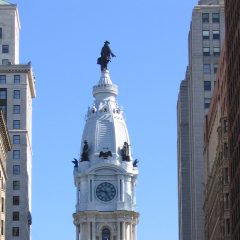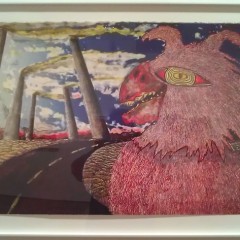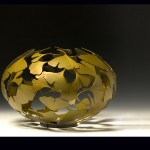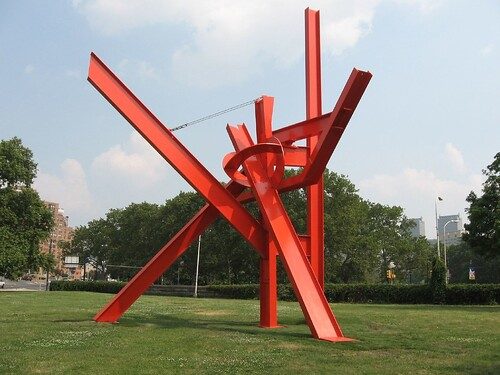
The big surprise at the Iroquois sculpture dedication and talk that followed at the Fairmount Park Art Association meeting was the artist himself, Mark di Suvero, a guy whose gargantuan I-beam constructions–with the occasional moving part–suggest testosterone on legs.
A smallish crowd of about 100 braved the heat, slight relief supplied by a tent and a light breeze. Everyone seemed to be smiling, as several speakers heaped praise all around. The president of the Fairmount Park Commission, Robert N.C. Nix III said the location of the sculpture was “the real Avenue of the Arts” and the sculpture and the FPAA were the “cherry on the top of the cream pie.”
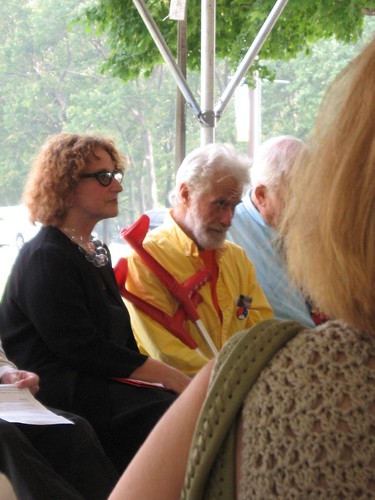
Sitting under the tent are Penny Balkin Bach and di Suvero.
FPAA’s Penny Balkin Bach, the leader of those saviors of Philadelphia public art, called the sculpture daring and bold, and praised di Suvero for using “the [construction] crane as his paintbrush.” Then she praised donor David Pincus whose generosity extends from the Philadelphia art world to around the world, where he participates in numerous programs that bring medical care to the needy. She spoke of the power of Iroquois to make Philadelphia look like a world class city. (I thought it did, but never mind).
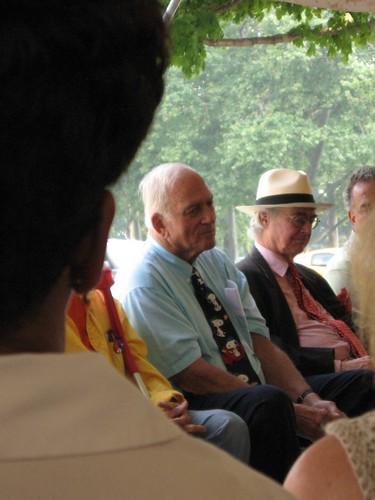
Donor David Pincus, in blue shirt with Snoopy tie (he has a family clothing business in his background)), sitting next to Fairmount Park Art Association President Charles E. Mather III. On the bit of di Suvero’s yellow shirt that is visible is a red white and blue peace pin.
Pincus himself spoke of his long relationship with di Suvero, from the time he met him in the late 1950s and bought a piece, now in the hands of the Philadelphia Museum of Art–its only di Suvero. He said Iroquois was Philadelphia’s first major di Suvero, and that it stood as the gateway to Fairmount Park. “Surely there’s an elegance to Iroquois that I’m sure you’ll all agree to,” he said.
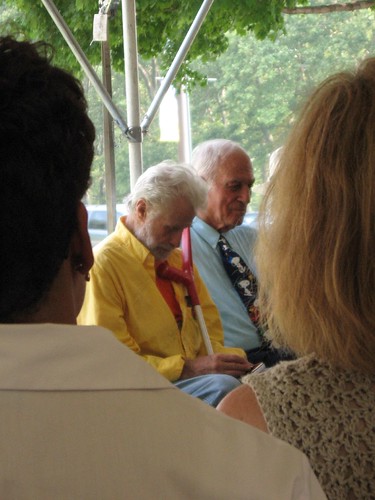
di Suvero, filled with emotion
Di Suvero bowed his head as praise came his way, emotion turning his face red to match his Iroquois. After receiving his FPAA medal, he praised the community of people who brought the sculpture to Philadelphia as “a wonderful thing.”
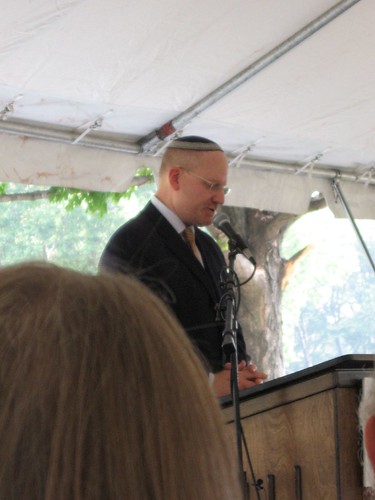
Rabbi Neil Cooper gave a benediction
At Pincus’ request, Rabbi Neil Cooper gave a benediction, part Hebrew, part English translation. I thought that was a first!!! He spoke of Bezaleil, the first artist mentioned in the Bible, and how he was filled with the spirit from God, and added that the same spirit was here. Then referring to the world situation, he offered a prayer “that we shall gather often for the sake of beauty and for the sake of brotherly love.” (These ideas of peace, community and the universal appeal of beauty were repeated by di Suvero in his talk, later on).
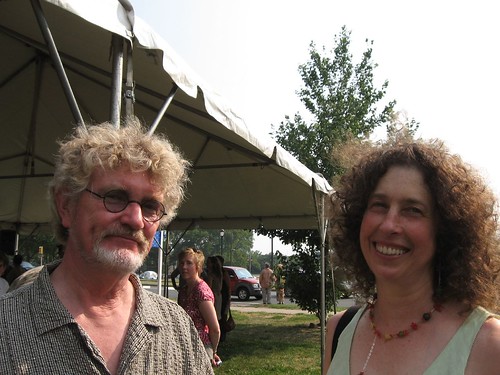
Warren Angle and Leslie Kaufman after the speech. I just noticed that’s Elisabeth Flynn in the background, from the PMA’s publicity department
Then we all trudged over to the Art Museum for the FPAA annual meeting and di Suvero’s talk (I love the FPAA artists’ talks). After a chat with Leslie Kaufman (Philly Sculptors) and Warren Angle (Fleisher Art Memorial), and then Tish Ingersoll (PMA) I walked over with Ava Blitz (who has a swell show of her stone carvings and castings at CFEVA, extended for a week until July 7). The FPAA talkers did their best to keep the annual meeting reports short, although Bach went on and on because this group does so much. Included was the progress report on John Kindness‘ button tabletops for Elmwood Park, part of the New Landmarks program. They have been cast at the foundry, so I guess that installation is coming soon!

Anne d’Harnoncourt, center, no title needed, and on the far right, a glimpse of Kim Sajet, formerly of PAFA but now CEO of the Historical Society of Pennsylvania. For a hot day, there were a lot of necklaces. Kudos especially to Sajet, Julie Courtney, and Bach for notable ones.
di Suvero is an earnest romantic, with a gentle voice. Of course, considering he has a broken back, he also has to be fierce to have made the bristling red Iroquois, which has a moving part that seems rather static. But the piece makes me think di Suvero is like the anti-Giacometti: Iroquois is human, and depends on a number of strategies to stand erect, which suggests vulnerability; but its I-beams shout power and stability; its coat of red cries out to be recognized.
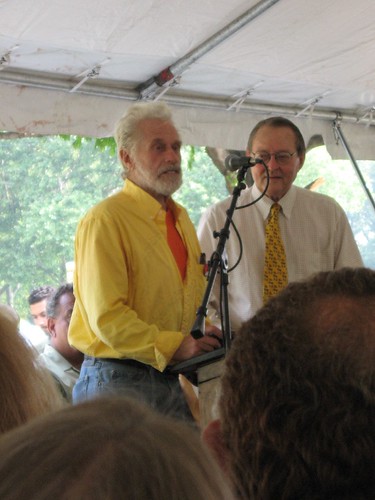
Di Suvero, listening to FPAA Secretary-Treasurer Theodore T. Newbold presenting the FPAA Medal of Honor. DiSuvero’s fabulous fashion-statement crutches are tucked out of sight under his left arm.
Di Suvero’s dress also called for attention–OSHA-yellow shirt over OSHA-orange T-shirt, with crayon-red Canadian crutches to match his sculpture (this counts as a sense of humor, I’d say). I wonder if someone gave them to him as a gift.
Di Suvero’s talk was about universal symbols in his art, the idea that we are all hard-wired to respond to certain shapes and marks. He himself often repeats a sort of knot in his work from which the I-beams radiate. He said he’s been writing a book about this idea of universal symbols for the last 30 years, and is still not finished. Later he said “these abstract forms” are his material.
He expressed less interest in the process–cutting steel, welding and drawing–than the result. “There’s the ectasy where the piece comes together.”
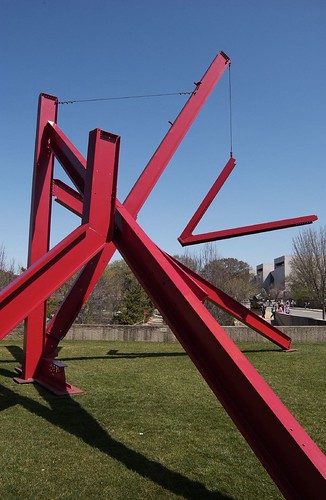
This is one of Mark di Suvero’s sculptures that David Pincus mentioned in his speech. He admired it for its gravity-defying qualities, but I think that’s something that’s in all of di Suvero’s work to some degree.
Mark di Suvero, American, b. Shanghai, China, 1933, Are Years What? (for Marianne Moore), 1967, Painted steel.approx. 40 x 40 x 30 feet. Joseph H. Hirshhorn Purchase Fund and Gift of the Institute of Scrap Recycling Industries, by exchange (99.19 ) Photo courtesy of the Smithsonian Institution
He acknowledged how moved he was “to see what David [Pincus] has given to the Fairmount Park Art Association, to the city.”
Then, reverting back to universal symbols, he began talking about how all of humanity is more the same than different and that it’s one world in which we live. “We’re going to have to stop the insanity of war,” he said, recalling that he himself was arresting for refusing to serve in Vietnam.
From there he marveled at how people in extreme poverty can still experience joy, and that art gave joy to people. There’s “a sense of knowledge of structure that liberates us,” he said, an elliptical reference to the idea of forms and shapes with universal significance.

Ball players share the triangle with the sculpture as the sun starts going down
Then, taking up our common humanity again, he veered straight into politics and ended with a bang. “We should certainly stop this war, which is based on lies. There are no weapons of mass destruction,” he said, adding that what the war is doing is destroying families–in Iraq and here. “And what we need to do, we need to impeach Cheney and Bush.”
The crowd applauded and laughed all at once, as di Suvero gingerly descended from the stage. What a romantic!!! I never would have guessed.
As usual there was an after party, which was a little less crowded than usual (weather? vacation time?)–and therefore easier to navigate. Angle and I made I beeline for the drinks, which were nice and icy and totally welcome. I’ve tried to intersperse pictures of some of the people I saw, but I didn’t get shots of others whom I should have, like Ava; or Inky art correspondent Edie Newhall; or book club buddy Clarissa Carnell (PMA) and her parter Hal (I don’t know his last name); Amy Lipton, from the Abington Art Center, and philosophical art criticSue Spaid. They were talking to sculptor Winifred Lutz for a while. Independent curators Marsha Moss and Julie Courtney were there. Moss, who never misses an art event, also never misses anything Murray writes, so we talked a bit about his article in the Sunday Inquirer Travel Section. I saw Claudia Gould from afar (as usual). I know there were lots more, but that’s the best I can do. Thanks goodness it was so hot, or there would have been gazillions more.



